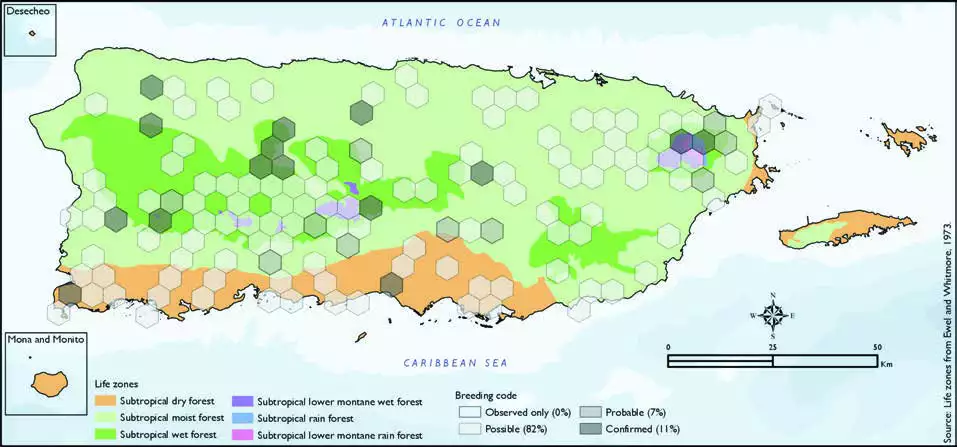Puerto Rican Emerald
Description
The Puerto Rican emerald (Riccordia maugeaus), or zumbadorcito de Puerto Rico in Spanish, is an endemic hummingbird found only in the archipelago of Puerto Rico.
Distribution & Habitat
The Puerto Rican Emerald is a hummingbird endemic
to Puerto Rico and relatively
common in most of the main
island, except on the east coast,
Culebra, and Vieques (Oberle
2018). It is absent from satellite
islands except Vieques where
it was first documented in
2003 and is considered a rare
visitor (Gemmill 2015). This
hummingbird occurs in mountain
forests, shade coffee plantations,
lowland wooded areas including
dry coastal habitats, mangroves,
and gardens (Gemmill 2015,
Oberle 2018, Raffaele and others
1998). The atlas fieldwork yielded a total of 200 records
within 137 hexagons or 29
percent of the 479 total hexagons
(see map). Of the 137 hexagons
where the Puerto Rican Emerald
was found, breeding met the
atlas definition of confirmed in
11 percent (15) of the hexagons,
probable in 7 percent (10), and
possible in 82 percent (112)
(see map). Puerto Rican Emerald distribution. The map shows the highest breeding code by hexagon and overlaying the ecological life zones
in Puerto Rico. Note: percentages may not total 100 due to rounding.

Breeding Habits
The Puerto Rican Emerald builds a cup-shaped nest made of soft
fibers (including spider webs)
coated with lichens (Raffaele
1989a). Previously published
reports indicate that it breeds 87Puerto Rican Emerald/Zumbadorcito de Puerto Ricoprimarily from February to May but also irregularly throughout
the year (Raffaele and others
1998). Atlas results suggest that
this species breeding season
extends throughout the year,
with the most breeding activity
from March through June (see
chart). Overall, the breeding
activity peaks in April, and it
mostly occurs in the subtropical
moist forest life zone. Results
show that this species breeds
throughout most of the island,
mainly within the subtropical moist forest life zone (47 percent
of the hexagons) (see table). It
also breeds within subtropical
wet and lower montane wet
forest life zones at higher
elevations (33 percent of the
hexagons), as well as in the
subtropical dry forest life zone
(20 percent of the hexagons)
(see table and map).
Conservation
The overall population size of the Puerto Rican Emerald has
not been quantified, but this species is described as common
and is listed as a species of least
concern by the IUCN (BirdLife
International 2016). Locally,
it is not listed in any of the
threatened categories used by
PRDNER and USFWS. In Puerto
Rico, the Puerto Rican Emerald
has a protected habitat in land
of 15 percent or 502 km2 of the total area covered by the
hexagons where evidence of
breeding was found for this
species (3278 km2).
Related Species
Family:
hummingbird